Just as SARS-CoV-2 infection can trigger certain autoimmune processes, such as Guillain-Barré syndrome, haemolytic anaemia or thrombocytopenic purpura,1 we present the case of two patients who developed elevated aminotransferases weeks after SARS-CoV-2 infection, with subsequent diagnosis of autoimmune hepatitis (AIH).
The first case was a 38-year-old female patient with a history of bronchial asthma and without previous elevation of transaminases, who suffered asymptomatic SARS-CoV-2 infection. Six weeks after a positive PCR test for SARS-CoV-2, a routine analysis was carried out in which analytical alterations in the liver profile were observed with a total bilirubin of 1.7 mg/dl, AST 1112 IU/L, ALT 1255 IU/l, AP 184 IU/l and GGT 150 IU/l, without coagulopathy. An aetiological study was negative for hepatitis A, B, C and E, while ceruloplasmin and alpha-1 antitrypsin levels were normal. An autoimmune study showed an IgG of 1890 mg/dl and ASMA 1/40. A kidney ultrasound was normal. One week before the transaminase elevation, the patient had started treatment with dienogest and ethinylestradiol (CIOMS/RUCAM score 3). The study was completed with a liver biopsy, which showed an intense lymphocytic infiltrate and plasma cells at the portal level and interface hepatitis, with intense lobular involvement and bridging necrosis without significant fibrosis. Given the diagnosis of AIH, the patient began treatment with prednisone and later with azathioprine, with normalisation of the liver profile. In addition, she was simultaneously diagnosed with Graves-Basedow's disease.
The second case was a 74-year-old man with no personal history of interest and no previous elevation of transaminases, who had SARS-CoV-2 infection with fever and anosmia as symptoms. He went to the hospital with jaundice 15 days after the SARS-CoV-2 infection, associated with choluria, acholia, epigastric pain and hyporexia. Laboratory tests at admission showed total bilirubin of 5.7 mg/dl and elevated liver enzymes, both cytolysis and cholestasis (AST 1055 IU, ALT 1011 IU/l, AP 239 IU/l, GGT 690 IU/l), with no evidence of liver failure. An aetiological test was performed, which was negative for hepatotropic viruses (A, B, C and E), and ceruloplasmin levels were normal. IgG was 2180 mg/dl. In the autoimmune study, ANA 1/160 stood out. Abdominal ultrasound showed some evidence of possible chronic liver disease (slight hypertrophy of the left hepatic lobe and slightly irregular borders), with normality in the rest of the examination. It was decided to perform a liver biopsy, the results of which showed a dense lymphoplasmacytic inflammatory infiltrate that exceeded the limit in more than 50% of the portal spaces, extending towards the lobule. There were no foci of generalised necrosis, nor ductal lesion, nor granulomas at the level of the portal spaces. Expansion of most of the portal spaces included in the sample was observed, with focal bridging (fibrosis score 3). Given the histological findings, treatment was started with prednisone and later with azathioprine, with normalisation of transaminases in subsequent analytical tests.
Table 1 summarises the most relevant data of the cases presented.
Clinical, analytical and histological characteristics of the cases.
| Characteristics | Patient 1 | Patient 2 |
|---|---|---|
| Sex/age | Female/38 years | Male/74 years |
| Personal history | Bronchial asthma | AHT |
| Toxic habits | No | 40 g of alcohol daily |
| Recent medication/herbal product use/travel | Sibilla® (dienogest and ethinyl estradiol) | No |
| Positive PCR for SARS-CoV-2 | 8 June 2020 | 22 November 2021 |
| COVID-19 vaccine | No | 1st and 2nd dose in April and May 2021 |
| Symptoms of SARS-CoV-2 infection | Asymptomatic | Intermittent fever + anosmia |
| Need for hospitalisation due to SARS-CoV-2 infection | No | No |
| Targeted treatment for SARS-CoV-2 infection | No | No |
| Date of test result abnormalities after SARS-CoV-2 infection | 22 July 2020 | 7 December 2021 |
| Symptoms related to liver impairment | Asymptomatic | Jaundice + choluria + acholia + abdominal discomfort + hyporexia |
| AST, IU/l | 1112 | 1055 |
| ALT, IU/l | 1255 | 1011 |
| AP, IU/l | 184 | 239 |
| GGT, IU/l | 150 | 690 |
| INR | 1 | 1.2 |
| PT, % | 100 | 81 |
| Total bilirubin, mg/dl | 1.7 | 5.3 |
| IgG, mg/dl | 1890 | 2180 |
| Autoimmunity | ASMA 1/40 | ANA 1/160 |
| Hepatotropic viruses (A, B, C and E) | Negative | Negative |
| Liver biopsy | Lymphoplasmacytic inflammatory infiltrate that exceeds the limit; interface hepatitis; bridging necrosis | Lymphoplasmacytic inflammatory infiltrate exceeding the limit |
| Absence of foci of generalised necrosis, no ductal lesion or granulomas at the level of the portal spaces | ||
| Simplified AIH score | 6 | 7 |
| Classic AIH score (after treatment) | 18 | 16 |
| Targeted AIH treatment | Prednisone, azathioprine | Prednisone, azathioprine |
Just as recent infections by hepatotropic and non-hepatotropic viruses2 can trigger the development of AIH, given the epidemiological situation in which we live, SARS-CoV-2 infection should be considered as a possible precipitating and aetiological factor for AIH. Thus, in the differential diagnosis of hypertransaminasaemia after SARS-CoV-2 infection, the diagnosis of AIH can be included, apart from liver damage caused by the virus itself and hepatotoxicity due to drugs.1
As previously mentioned, SARS-CoV-2 infection has been associated with the appearance of immune-mediated diseases both during and after infection.1 During SARS-CoV-2 infection, the serum levels of various cytokines such as TNFα, IFN-γ, IL-1β, IL-6 and IL-10 increase, which, in turn, are also involved in the AIH inflammatory process itself. Therefore, it cannot be ruled out that said infection acts as an aetiological factor in the de novo appearance of AIH, or as a precipitant of an outbreak in the case of latent AIH.1
There are some cases described in the literature of AIH development during active infection by SARS-CoV-2.1,3–6 In the cases described above, it is likely that the AIH developed weeks later, although as these are paucisymptomatic SARS-CoV-2 infections that did not require admission, no laboratory tests were performed during the infection or in the days immediately following the infection. Therefore, the exact time of onset of hepatitis is unknown, although the symptoms in the case in which there were symptoms began 15 days after infection.







